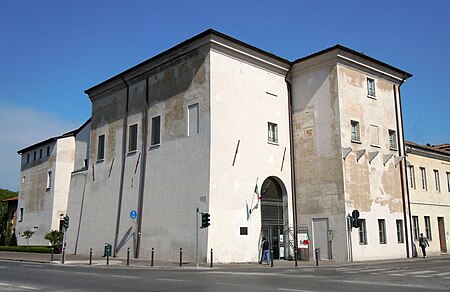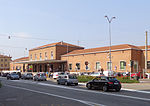Mantua ( MAN-tew-ə; Italian: Mantova [ˈmantova] ; Lombard and Latin: Mantua) is a comune (municipality) in the Italian region of Lombardy, and capital of the province of the same name.
In 2016, Mantua was designated as the Italian Capital of Culture. In 2017, it was named as the European Capital of Gastronomy, included in the Eastern Lombardy District (together with the cities of Bergamo, Brescia, and Cremona).
In 2008, Mantua's centro storico (old town) and Sabbioneta were declared by UNESCO to be a World Heritage Site. Mantua's historic power and influence under the Gonzaga family has made it one of the main artistic, cultural, and especially musical hubs of Northern Italy and the country as a whole. Having one of the most splendid courts of Europe of the fifteenth, sixteenth, and early seventeenth centuries. Mantua is noted for its significant role in the history of opera; the city is also known for its architectural treasures and artifacts, elegant palaces, and the medieval and Renaissance cityscape. It is the city where the composer Monteverdi premiered his opera L'Orfeo and to where Romeo was banished in Shakespeare's play Romeo and Juliet. It is the nearest town to the birthplace of the Roman poet Virgil, who is commemorated by a statue at the lakeside park "Piazza Virgiliana".
Mantua is surrounded on three sides by artificial lakes, created during the 12th century as the city's defence system. These lakes receive water from the River Mincio, a tributary of the River Po which descends from Lake Garda. The three lakes are called Lago Superiore, Lago di Mezzo, and Lago Inferiore ("Upper", "Middle", and "Lower" Lakes, respectively). A fourth lake, Lake Pajolo, which once served as a defensive water ring around the city, dried up at the end of the 18th century.
The area and its environs are important not only in naturalistic terms, but also anthropologically and historically; research has highlighted a number of human settlements scattered between Barche di Solferino and Bande di Cavriana, Castellaro and Isolone del Mincio. These dated, without interruption, from Neolithic times (5th–4th millennium BC) to the Bronze Age (2nd–1st millennium BC) and the Gallic phases (2nd–1st centuries BC), and ended with Roman residential settlements, which could be traced to the 3rd century AD.
In 2017, Legambiente ranked Mantua as the best Italian city for the quality of the life and environment.











